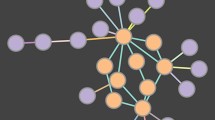Abstract
Distributions of the size of the largest component of the 2-core for Erdos-Rényi (ER) random graphs with finite connectivity c and a finite number N of nodes are studied. The distributions are obtained basically over the full range of the support, with probabilities down to values as small as 10−320. This is achieved by using an artificial finite-temperature (Boltzmann) ensemble. The distributions for the 2-core resemble roughly the results obtained previously for the largest components of the full ER random graphs, but they are shifted to much smaller probabilities (c ≤ 1) or to smaller sizes (c > 1). The numerical data is compatible with a convergence of the rate function to a limiting shape, i.e., the large-deviations principle apparently holds.
Similar content being viewed by others
References
A.K. Hartmann, Big Practical Guide to Computer Simulations (World Scientific, Singapore, 2015)
D.C. Rapaport, The Art of Molecular Dynamics Simulation (Cambridge University Press, Cambridge, GB, 2004)
J.N. Reddy, Introduction to the Finite Element Method (Mcgraw-Hill Education, Columbus, USA, 2005)
M.E.J. Newman, G.T. Barkema, Monte Carlo Methods in Statistical Physics (Clarendon Press, Oxford, 1999)
D.P. Landau, K. Binder, Monte Carlo Simulations in Statistical Physics (Cambridge University Press, Cambridge, 2000)
F. den Hollander, Large Deviations (American Mathematical Society, Providence, 2000)
A. Dembo, O. Zeitouni, Large Deviations Techniques and Applications (Springer, Berlin, 2010)
A.K. Hartmann, Phys. Rev. E 65, 056102 (2002)
S. Wolfsheimer, B. Burghardt, A.K. Hartmann, Algor. Mol. Biol. 2, 9 (2007)
L. Newberg, J. Comp. Biol. 15, 1187 (2008)
R. Durbin, S.R. Eddy, A. Krogh, G. Mitchison, Biological Sequence Analysis (Cambridge University Press, Cambridge, 2006)
A. Engel, R. Monasson, A.K. Hartmann, J. Stat. Phys. 117, 387 (2004)
A.K. Hartmann, Phys. Rev. Lett. 94, 050601 (2005)
M. Körner, H.G. Katzgraber, A.K. Hartmann, JSTAT 2006, P04005 (2006)
C. Monthus, T. Garel, Phys. Rev. E 74, 051109 (2006)
Y. Matsuda, H. Nishimori, K. Hukushima, J. Phys. A: Math. Theor. 41, 324012 (2008)
Y. Iba, K. Hukushima, J. Phys. Soc. Japan 77, 103801 (2008)
S. Wolfsheimer, A.K. Hartmann, Phys. Rev. E 82, 021902 (2010)
T.A. Driscoll, K.L. Maki, SIAM Review 49, 673 (2007)
N. Saito, Y. Iba, K. Hukushima, Phys. Rev. E 82, 031142 (2010)
A.K. Hartmann, S.N. Majumdar, A. Rosso, Phys. Rev. E 88, 022119 (2013)
A.K. Hartmann, Phys. Rev. E 89, 052103 (2014)
A.K. Hartmann, Eur. Phys. J. B 84, 627 (2011)
J. Chalupa, P.L. Leath, G.R. Reich, J. Phys. C 12, L31 (1979) http://stacks.iop.org/0022-3719/12/i=1/a=008
S.B. Seidman, Social Netw. 5, 269 (1983)
G.D. Bader, C.W. Hogue, BMC Bioinformatics 4, 2 (2003)
P. Erdös, A. Rényi, Publ. Math. Inst. Hungar. Acad. Sci. 5, 17 (1960)
N. O'Connell, Probab. Theo. Relat. Fields 110, 277 (1998)
N. Metropolis, A.W. Rosenbluth, M.N. Rosenbluth, A. Teller, E. Teller, J. Chem. Phys. 21, 1087 (1953)
A.M. Ferrenberg, R.H. Swendsen, Phys. Rev. Lett. 63, 1195 (1989)
A.K. Hartmann, in New Optimization Algorithms in Physics, edited by A.K. Hartmann, H. Rieger (Wiley-VCH, Weinheim, 2004), p. 253
B.A. Berg, T. Neuhaus, Phys. Rev. Lett. 68, 9 (1992)
F. Wang, D.P. Landau, Phys. Rev. Lett. 86, 2050 (2001)
B. Pittel, J. Spencer, N.C. Wormald, J. Comb. Theory B 67, 111 (1996)
A.K. Hartmann, M. Weigt, Phase Transitions in Combinatorial Optimization Problems (Wiley-VCH, Weinheim, 2005)
Author information
Authors and Affiliations
Corresponding author
Rights and permissions
About this article
Cite this article
Hartmann, A.K. Large-deviation properties of the largest 2-core component for random graphs. Eur. Phys. J. Spec. Top. 226, 567–579 (2017). https://doi.org/10.1140/epjst/e2016-60368-3
Received:
Revised:
Published:
Issue Date:
DOI: https://doi.org/10.1140/epjst/e2016-60368-3



